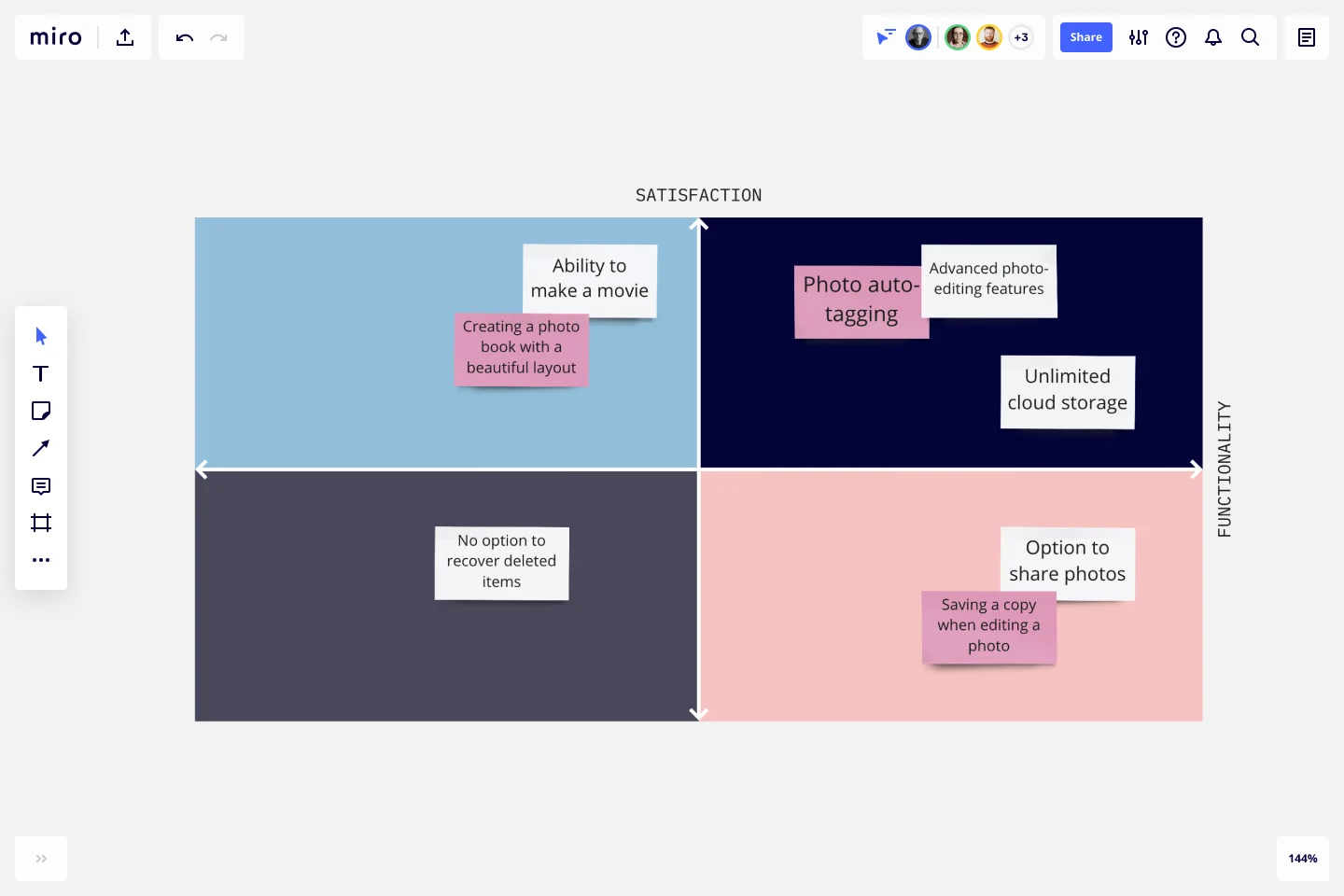Kano Model Template
Kano Analysis is a powerful tool where you can map which product attributes which are perceived to be important to customers. Ideal for product development and customer satisfaction.
Trusted by 65M+ users and leading companies
About the Kano model template
What is the Kano model?
The Kano model is a method for prioritizing features on a product roadmap. Prioritization is assigned based on the likelihood that a given feature will satisfy your customers. Product teams can use the Kano model to weigh a high-satisfaction feature against the costs of implementation, making it easier to decide whether they should add this feature to the roadmap. Many product managers prioritize features by grouping them into categories based on whether they are likely to disappoint, satisfy, or delight customers.
How does the Kano model work?
The Kano model uses two axes: satisfaction and functionality. The axes create a quadrant with four values: attractive, performance, indifferent, and must-be. Teams can use this model to understand, prioritize, and integrate the main categories of customer requirements into the products they develop. When teams understand which requirements are most valuable to customers, they can plan and use resources wisely.
What are the four categories in the Kano model?
The Kano model classifies features into four categories based on how customers might react to them.
Performance: These features directly impact whether the product is good at performing its intended function. Put another way: the more of this feature you receive, the greater your satisfaction will be. Gas mileage is the most common example. When you’re buying a car, you treat gas mileage as a Performance attribute.
Must-be: Customers expect these features. If your product doesn’t have one, then your customers will consider your project bad or incomplete. For example, you expect your car to have brakes. If it doesn’t have brakes, you’re not buying it.
Attractive: Although these features aren’t strictly necessary, they cause a positive reaction. A leather interior doesn’t make a car work any better, but it’s nice to have and increases the value of the car.
Indifferent: The presence or absence of this feature does not impact you in any way. Organizations typically avoid working on features that fall into this category because they are a waste of resources.
Create your own
Now that you know how to create your own Kano model, get started with this free template. It’s easy to create and share it with your teammates.
Get started with this template right now.
Agenda Template
Works best for:
Project Management, Meetings, Workshops
Even when you’ve hosted meetings for years, hosting them online is different. Keeping them structured, purposeful, and on-task is key. That all starts with having a detailed agenda, and this template makes it so easy for you to create one.
Year Timeline Template
Works best for:
Timeline, Planning
The Year Timeline template provides a comprehensive view of annual events and milestones. Perfect for planning yearly goals, tracking progress, and scheduling important dates, this template helps you stay organized and focused throughout the year.
Product Management Onboarding Map
Works best for:
Product Management, Planning
Product Management Onboarding Map template facilitates the onboarding of new product management team members. By outlining key responsibilities, processes, and stakeholder interactions, this template helps new hires quickly acclimate to their roles. With sections for setting learning objectives and resources, it supports structured onboarding experiences, ensuring that new team members are equipped with the knowledge and tools needed to contribute effectively to product initiatives.
Start, Stop, Continue Retrospective by Laura Timmins
Works best for:
Retrospectives, Agile Methodologies
The Retrospective template offers a flexible and customizable framework for teams to reflect on past experiences and identify areas for improvement. It provides elements for sharing successes, challenges, and action items. This template enables teams to facilitate constructive discussions, generate insights, and drive continuous improvement. By promoting reflection and collaboration, the Retrospective empowers teams to optimize performance and achieve their goals effectively.
Product / Market Fit Canvas Template
Works best for:
Market Research, Strategic Planning, Product Management
The product/market fit canvas template is used to help product teams meet customer and market needs with their product design. This template looks at a product in two dimensions: first, how the product fits user needs, and second, how the fully designed product fits within the market landscape. This combined metric understands a product holistically from the way customers use and desire a product, to the market demand. By comparing customer and product qualities side by side, users should better understand their product space and key metrics.
Job Map Template
Works best for:
Design, Desk Research, Mapping
Want to truly understand your consumers’ mindset? Take a look at things from their perspective — by identifying the “jobs” they need to accomplish and exploring what would make them “hire” or “fire” a product or service like yours. Ideal for UX researchers, job mapping is a staged process that gives you that POV by breaking the “jobs” down step by step, so you can ultimately offer something unique, useful, and different from your competitors. This template makes it easy to create a detailed, comprehensive job map.
